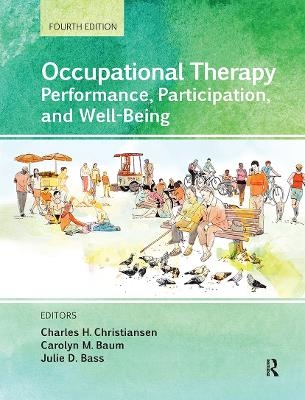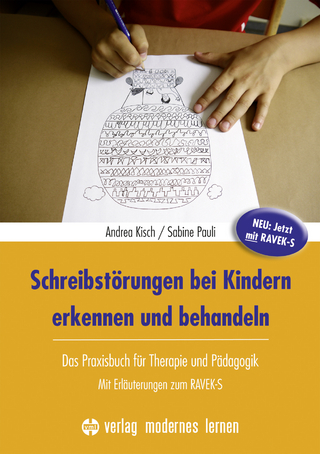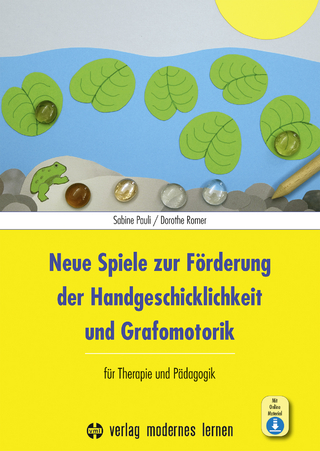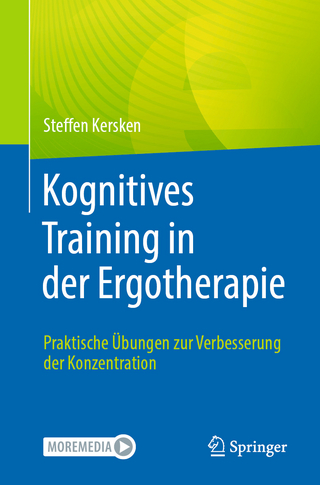
Occupational Therapy
SLACK Incorporated (Verlag)
978-1-61711-050-4 (ISBN)
Occupational Therapy: Performance, Participation, and Well-Being, Fourth Edition, is a comprehensive occupational therapy text that introduces students to core knowledge in the profession and the foundations of practice—the occupations, person factors, and environment factors that support performance, participation, and well-being.
Editors, Drs. Charles H. Christiansen, Carolyn M. Baum, and Julie D. Bass, are joined by more than 40 international scholars who bring students, faculty, and practitioners the evidence that supports occupational therapy practice. The PEOP Model 4th Edition is featured as an exemplar of a person-environment-occupation model and provides a valuable roadmap for understanding key concepts and developing strong clinical reasoning skills in the occupational therapy process.
Features:
Examines the theories, models, frameworks, and classifications that support contemporary knowledge of person, environment, and occupational factors.
Presents detailed chapters on the occupations of children and youth, adults, older adults, organizations, and populations
Provides extensive coverage of the person factors (psychological, cognition, sensory, motor, physiological, spirituality) and environment factors (culture, social, physical, policy, technology) that support occupational performance
Includes exceptional content on the essentials of professional practice - therapeutic use of self, evidence-based practice, professionalism, lifelong development, ethics, business fundamentals, and critical concepts
Builds clear links with the AOTA’s Occupational Therapy Practice Framework, Third Edition; International Classification of Functioning, Disability and Health, and accreditation standards for entry-level occupational therapy programs.
Introduces emerging practice areas of self-management, community-based practice, technology, and teaching/learning and opportunities to work with organizations and populations
Incorporates international and global perspectives on core knowledge and occupational therapy practice.
Documents assessments, interventions, resources, and evidence in user-friendly tables
Uses simple and complex cases to illustrate key concepts and ideas.
New and Updated Sections in the Fourth Edition:
Individual chapters on each person factor and environmental factor and occupations across the lifespan
Expanded coverage of approaches for organizations and populations and entry-level professional skills
Consistent framework of tables and language across chapters and sections.
Included with the text are online supplemental materials for faculty use in the classroom including PowerPoint presentations.
Charles H. Christiansen, EdD, OTR, FAOTA is Executive Director of The American Occupational Therapy Foundation in Bethesda, Maryland, and Clinical Professor, Division of Rehabilitation Sciences, at the University of Texas Medical Branch in Galveston, Texas. Dr. Christiansen is also Principal and Founder, StoryCrafting, Inc, LLC, a private consulting firm for life transitions based in Rochester, Minnesota. As a former senior academic administrator and tenured professor at the University of Minnesota, the University of Texas Medical Branch, and the University of British Columbia, he developed graduate programs and worked on his own research, focusing on patterns of human occupation and their relationship to health, particularly as buffers to create resiliency to stress-related illness and disability. Dr. Christiansen is a Fellow of the American Occupational Therapy Association and a past Vice President and Treasurer of that organization. He is the founding editor of the scientific journal OTJR: Occupation, Participation and Health, now well into its fourth decade of publication. Carolyn M. Baum, PhD, OTR/L, FAOTA is the Elias Michael Director and Professor of Occupational Therapy, Neurology, and Social Work at Washington University School of Medicine in St. Louis, Missouri. Dr. Baum has twice served as President of the American Occupational Therapy Association and was President of the American Occupational Therapy Certification Board (now NBCOT). She currently serves as the Chair of the American Occupational Therapy Foundation’s Research Commission and serves on the Executive Board of the Foundation. She has served on the National Center for Medical Rehabilitation Research at the National Institutes of Health and the Institute of Medicine’s Committee to Assess Rehabilitation Science and Engineering Needs. In those capacities, she contributed to reports to Congress. Dr. Baum’s research is on the relationship of occupation and participation in persons with chronic neurological conditions. She is engaged in research to determine effective interventions and continues her work in the measurement of occupational performance. She consistently contributes her work and the work of her mentees and students to scholarly journals and texts. Dr. Baum was inducted into the AOTF Academy of Research in 2006 for her exemplary and distinguished contributions toward the science of occupational therapy. Julie D. Bass, PhD, OTR/L, FAOTA is Professor and past Chair, Occupational Science and Occupational Therapy, at St. Catherine University in St. Paul, Minnesota. She was the Founding Director of the Public Health Program at St. Catherine University. Dr. Bass also serves as the Director of Research and Associate Director of the Institute for the Study of Occupation and Health at the American Occupational Therapy Foundation. She is an established and well-published scholar who has been a frequent presenter at national and international conferences and an invited member on several AOTA task force committees. Her areas of expertise include population health and health disparities, program development and evaluation, statistics and research methods, educational methods, and emerging areas of practice for occupational therapy. Dr. Bass is a Fellow of the American Occupational Therapy Association.
Dedication Acknowledgments About the Editors Contributing Authors Preface Section I Occupational Therapy: Promoting Occupational Performance, Participation, and Well-Being and Placing the Focus on Everyday Life Chapter 1 A Welcome to Occupational Therapy: Performance, Participation, and Well-Being, Fourth Edition Julie D. Bass, PhD, OTR/L, FAOTA; Carolyn M. Baum, PhD, OTR/L, FAOTA; and Charles H. Christiansen, EdD, OTR, FAOTA Chapter 2 Health, Occupational Performance, and Occupational Therapy Charles H. Christiansen, EdD, OTR, FAOTA; Carolyn M. Baum, PhD, OTR/L, FAOTA; and Julie D. Bass, PhD, OTR/L, FAOTA Chapter 3 Theory, Models, Frameworks, and Classifications Carolyn M. Baum, PhD, OTR/L, FAOTA; Julie D. Bass, PhD, OTR/L, FAOTA; and Charles H. Christiansen, EdD, OTR, FAOTA Chapter 4 The Person-Environment-Occupation-Performance (PEOP) Model Carolyn M. Baum, PhD, OTR/L, FAOTA; Charles H. Christiansen, EdD, OTR, FAOTA; and Julie D. Bass, PhD, OTR/L, FAOTA Chapter 5 Interventions and Outcomes: The Person-Environment-Occupation-Performance (PEOP) Occupational Therapy Process Julie D. Bass, PhD, OTR/L, FAOTA; Carolyn M. Baum, PhD, OTR/L, FAOTA; and Charles H. Christiansen, EdD, OTR, FAOTA Chapter 6 Therapeutic Use of Self: A Catalyst in the Client-Therapist Alliance for Change Helene J. Polatajko, PhD, OTReg(Ont), OT(C), FCAOT, FCAHS; Jane A. Davis, MSc, OTReg(Ont), OTR, OT(C); and Sara E. McEwen, PhD, MSc, BSc(PT) Chapter 7 Using Evidence to Guide Practice Sally Bennett, PhD, BOccThy(Hons) Section II Critical Elements of Occupation and Occupational Performance Chapter 8 The Complexity and Patterns of Human Occupations Lena-Karin Erlandsson, PhD, RegOT and Charles H. Christiansen, EdD, OTR, FAOTA Chapter 9 Occupations of Childhood and Adolescence Sylvia Rodger, BOccThy, MEdSt, PhD; Jenny Ziviani, BAppSc(OT), MOccThy, PhD; and Sok Mui Lim, BOT(Hons), GCert Higher Ed, PhD Chapter 10 Occupations of Adulthood Kathleen Matuska, PhD, OTR/L, FAOTA and Kate Barrett, OTD, OTR/L Chapter 11 Occupations of Elderhood Gunilla Eriksson, RegOT, PhD; Margareta Lilja, RegOT, PhD; Hans Jonsson, RegOT, PhD; Ingela Petersson, RegOT, PhD; and Verena C. Tatzer, OT, MSc Chapter 12 Occupations of Organizations Carol Haertlein Sells, PhD, OTR, FAOTA Chapter 13 Occupations of Populations Julie D. Bass, PhD, OTR/L, FAOTA Section III Person Factors That Support Occupational Performance Chapter 14 Person Factors: Psychological Catana Brown, PhD, OTR/L, FAOTA and Virginia C. Stoffel, PhD, OT, BCMH, FAOTA Chapter 15 Person Factors: Cognition Adina Maeir, PhD, OT and Shlomit Rotenberg-Shpigelman, MSc, OT Chapter 16 Person Factors: Sensory Leeanne M. Carey, BAppSc(OT), PhD, FAOTA Chapter 17 Person Factors: Motor Lisa L. Dutton, PhD, PT and Julie D. Bass, PhD, OTR/L, FAOTA Chapter 18 Person Factors: Physiological Sandra L. Rogers, PhD, OTR/L Chapter 19 Person Factors: Meaning, Sensemaking, and Spirituality Aaron M. Eakman, PhD, OTR/L Section IV Environment Factors That Support Occupational Performance Chapter 20 Environment Factors: Culture René Padilla, PhD, OTR/L, FAOTA, LMHP Chapter 21 Environment Factors: Social Determinants of Health, Social Capital, and Social Support Julie D. Bass, PhD, OTR/L, FAOTA; Carolyn M. Baum, PhD, OTR/L, FAOTA; Charles H. Christiansen, EdD, OTR, FAOTA; and Kathryn Haugen, REHS/RS Chapter 22 Environment Factors: Physical and Natural Environment Susan Stark, PhD, OTR/L; Jon Sanford, MArch; and Marian Keglovits, OTD, MSCI Chapter 23 Environment Factors: Health, Education, Social, and Public Policies Diane L. Smith, PhD, OTR/L, FAOTA and Stan A. Hudson, MA Chapter 24 Environment Factors: Technology Jan Miller Polgar, PhD, OTReg(Ont), FCAOT Section V Interventions: Principles and Emerging Approaches Chapter 25 Principles Supporting Intervention and Professionalism John D. Fleming, EdD, OTR/L and Penelope A. Moyers Cleveland, EdD, OT/L, FAOTA Chapter 26 A Person-Centered Strategy: Using Learning Strategies to Enable Performance, Participation, and Well-Being Timothy J. Wolf, OTD, MSCI, OTR/L and Naomi Josman, PhD, OT(I) Chapter 27 An Organization-Centered Strategy: Self-Management—An Evolving Approach to Support Performance, Participation, and Well-Being Joy Hammel, PhD, OTR/L, FAOTA; Marcia Finlayson, PhD, OTReg(Ont), OTR; and Danbi Lee, OTD, OTR/L Chapter 28 Educational and Digital Technology Strategies Anita L. Hamilton, BAppSc(OT), MOccThy, Grad Cert(Higher Ed), PhD(Cand) and Alec I. Hamilton, BEd(Sci), Grad Dip App Child Psych, MAnaly Psych, MCouns(Psych) Chapter 29 A Population-Centered Strategy: Public and Community Health Gretchen V. M. Stone, PhD, OTR, FAOTA Section VI Foundational Knowledge and Resources Chapter 30 Enabling Successful Practice Through Application of Business Fundamentals Patricia Nellis, MBA, OTR/L Chapter 31 Key Occupational Therapy Concepts in the Person-Occupation-Environment-Performance Model: Their Origin and Historical Use in the Occupational Therapy Literature Kathlyn L. Reed, PhD, OTR, FAOTA, MLIS Financial Disclosures Index
| Erscheint lt. Verlag | 31.1.2015 |
|---|---|
| Sprache | englisch |
| Maße | 216 x 279 mm |
| Gewicht | 1440 g |
| Themenwelt | Medizin / Pharmazie ► Physiotherapie / Ergotherapie ► Ergotherapie |
| ISBN-10 | 1-61711-050-7 / 1617110507 |
| ISBN-13 | 978-1-61711-050-4 / 9781617110504 |
| Zustand | Neuware |
| Haben Sie eine Frage zum Produkt? |
aus dem Bereich


